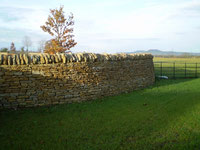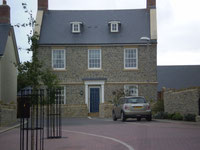Drystone



Drystone for impressive drystone walls
For millennia man has used drystone walling to enclose land, providing protection, and enclosure in an entirely natural way. This is why drystone walling is so revered. Drystone walls provide purpose of protecting a field, a farm, an estate, or a garden, and yet harmonises with the landscape.
A well built drystone wall will last hundreds of years, creating a legacy from one generation to another. All you need is good drystone, and a craftsman stone mason to build it.

Supplier of drystone
We are a supplier of drystone, throughout the West Country, and upto the Cotswolds.
drystone wallers use our stone due to its supreme quality. It is easy to build good looking, stable drystone walls fast, with, or without mortar, or a backing block.
Our drystone is also ideal for retaining walls, and large, long lasting estate drystone walls that will make an impression.
Our drystone is:
- Hard
- Flat (this creates more stable walls, and is faster to build with)
- Cropped and dressed to have at least one straight face
The drystone has a large amount of through stones (upto about 18 inches) helping with stability. This makes it ideal for the construction of estate walls that are not only beautiful, but are also substantial in size and presence.
We can also provide coping stones, cock and hens, as well as base stones. These will all help with the stability of the wall, as well as the all important aesthetics.
Each stone is ready to pick up, and put straight into the drystone wall. Minimising the selection, and dressing of the stone, thus lowering the cost of the build.
Furthermore the rich colours or browns, buffs and green/greys create a mottled colour, blending naturally with the landscape.
For smaller drystone walls, or when using a backing block, use our 7 inch or 10 inch cropped walling. Lime mortar can be used with this smaller walling stone. The mortar can be recessed back, giving a dry stone effect.
If you want to discuss your plans, phone the Quarry on 01963 364200 - for PRICING

Drystone walling projects
In the past 25 years, we have provided drystone for some of the largest drystone walling projects in the country, that are literally ground-breaking. The Newt, near Bruton is an excellent example where there are several miles of drystone walls built through the parkland. Much of the drystone walling at the Newt has been done with stone supplied by Stalbridge Quarries, and built by Tom Trouton.
Have a look at this interview with Tom by Country Life. This is our is our drystone:
The art of drystone walling is very much alive. It is an art, it makes a statement, it is entirely natural, and is highly practical. These beautiful structures, that are of the landscape, will add huge value to a property.
Drystone walling has been used for thousands of years in the UK, and can be seen in the brochs of the Orkney Islands, withstanding the elements for several thousand years. The caveat to drystone walling is that the stone needs to be hard and flat, and you need a good drystone waller.
Look at our photos.
If you want to discuss your plans, phone the Quarry on 01963 364200

Dry stone walls defining landscapes
Dry stone walls are one of the earliest forms of construction, that has defined many of landscapes over the past centuries. Dry stone walls are simple (needing only stone and craftsmanship), but highly effective, lasting hundreds of years.
The Cotswolds, the Purbecks, the Mendips, the Dales, and Cumbria are a few of the iconic regions in the country that have been defined by drystone walls. It is worth noting that our stone is a type of Cotswold walling stone. We deliver our Cotswold walling stone not only to Wiltshire, but also upto, Gloucestershire, and Oxfordshire.
These traditional walls are works of art, relying on the craftmanship of the drystone wallers to utilise the available stone to create a permanent barrier that will prevent livestock escaping in an often hilly, or mountainous landscape.
Today our drystone is used in gardens, estates, and farms creating walls that mould with the landscape, and environment. It is the very nature of dry stone walling that enables it to sit easily within the environment. An entirely natural construction, just using stone, gravity, and supreme craftmanship.
Traditionally, no mortar was used, relying on high quality stone, and craftsmanship to harness gravity to produce a stable, and strong wall that would last generations. Today, builders, and stone mason often use a lime based mortar, recessed back, to provide extra stability. This can be taken further when using cropped walling, where a backing block can be added.

 Stalbridge Quarries
Stalbridge Quarries






